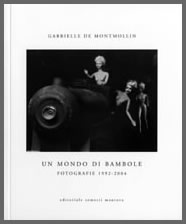The first
artist to make dolls a photographic obsession was the surrealist Hans
Bellmer, but if we had to list all the artists who have used photography
to present the human puppet as the main character of aesthetic meditations,
we would face a very difficult undertaking. In the vast visual archive
of photography we find dolls tortured and put to death; dolls played
with and adored; dolls used as a feminine metaphor; and women, themselves,
as dolls. Dolls have even represented dreams of the most unrestrained
and erotic fantasies. In almost all “assembled” photographs
where dolls are protagonists, their function as children's toys is implicit.
The rhetorical figures employed by artists to give meaning to their
images end up revolving around this function, either by alikeness or
opposition. Some symbolic and intruiging meanings from the past are
today obsolete, having lost their significance: in fact dolls have been
the object of vows, magic, worship, funeral gifts, amulets, talismans,
in a word, an object for grown ups and not just for children.
Since adults mostly credit desirable and sweet sentiments to the world
of children - candor, goodness, sweetness and naivety - the humanized
toy epitomizes them all, especially when it becomes imitation and/or
caricature, not only of grown adults, but of children themselves. Dolls
should therefore not suggest violent sentiments, death or perversion.
Contemporary artists after having assimilated the irreverent lessons
of some avant-garde artists (as well as writers and horror film directors
who have portrayed dolls as a bunch of blood thirsty demons) shatter
and deliberately jeer at this belief.
For his photographs of Puppe Hans Bellmer was inspired by police photos,
especially of atrociously killed corpses, tangled up and forming deformed
curves. Mario De Biasi, during the second half of the seventies, looking
at orchards where throw-away toys are used as scarecrows, gathered -
in a photo book titled L'orto delle bambole (The Orchard of the Dolls)
- a photographic sample of torture (impaled, dismembered, beheaded and
scorched dolls) outshining II giardino dei supplizi (The Torture Garden)
by Mirabeau. Between the end of the 20th century and the beginning of
the 21st, David Levinthal and Marty Tetloff transformed dolls (especially
the famous Barbie dolls produced by Mattel) into protagonists of slick
adult eroticism; others have gone a step further making them the heroes
of pornographic adventures.
The work of Gabrielle de Montmollin does not include dismembered dolls;
her creatures have no sharp teeth and they do not suggest explicit sexual
activities. The world inhabited by dolls offered by this Canadian artist
is a visionary female world, where a thin atmosphere is dominated by
anguish and mystery.
Some photographers such as Eugenio Oiler and Jeffery Scott create a
sentiment of discomfort paired with astonishment, by combining either
digital images of dolls' heads with lustful, naked female bodies or
beautiful faces of girls united with dummies and articulated dolls.
When Gabrielle de Montmollin creates hybrid women in the Bird Women
series, the female body is a doll body, while the birds heads are also
obtained from toys. This is accomplished without digital enhancement
but through effects before shooting (on the mini set in the studio)
and during printing by manipulating paper negatives.
While some artists, such as Jose Rodriguez, create their doll worlds
by thinking of the toys invading or plagiarizing the world of human
beings, contrarily, Gabrielle de Montmollin imagines a place parallel
to the human world, inhabited only with dolls. She uses them as a mirror
of women's condition, falling neither into feminist or victim condemnation
nor the allegorical, which emphasizes social commitment.
The Canadian artist is unique in her work with dolls and cannot be compared
to other experiences of contemporary photography. If we want to find
some famous precursors to the creativity of Gabrielle de Montmollin,
we should look to the period between the two World Wars, Parisian surrealism
and German expressionism. Sometimes her Barbie dolls wear agonizing
masks which hide their features, sometimes her dolls dwell in nocturnal
worlds on paper negatives (a distressing device Mumau, the great expressionist
movie director, experimented with successfully in Nosferatu). Yet often
a subtle humor matches the rarified atmospheres of mystery and anxiety
and peeps out in the titles of her works: The meticulous construction
of the tranquil life of Amazons, Leading Ladies, Camevale at the Hotel
of the Bridge of Sighs, Train Time Is Any Time, Miss Milligan and La
Belle Lucie, at the dance, and Bird Women (all included in
this exhibition). Often the titles of these series do not describe the
images that form them, but they complete the feeling. Apparently unconnected
to the subject being portrayed, sometimes the title is chosen after
the work has been completed and - Gabrielle says - according to a feeling
she perceives.
In the photos of Gabrielle de Montmollin nothing is taken for granted
and nothing is facile. Her work radiates an unquestionable and indescribable
fascination. I don't know why, but when I look at her work I think of
Friedrich Dürrenmatt; maybe because Switzerland unites them both:
although Gabrielle was born and raised in Canada, her parents are Swiss
as is part of her education (Geneva). Maybe the reason lies in the fact
that, as did Dürrenmatt, Gabrielle confronts the world she is living
in with an anti-world she creates in her own mind.
